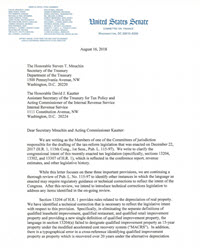The Environmental Protection Agency (EPA) announced this week that long-anticipated, updated ENERGY STAR scores that rate and compare U.S. buildings' energy performance will be available on Monday, August 27. [EPA website]
 |
The EPA currently lists 34,226 commercial buildings and plants located in all 50 states as ENERGY STAR-labeled – representing 4.95 trillion square feet of space. |
 |
EPA's annual Top Cities list shows which metro areas were home to the most ENERGY STAR certified buildings in the previous year. |
EPA's recommendations for how to prepare for the upcoming changes and webinars about the new metrics are available online.
Club for Growth founder and economic advisor to the Trump 2016 campaign, Stephen Moore, writes in an August 15 op-ed that boosting foreign tourism to the United States will increase economic growth and lower the trade deficit — a view shared by the VisitU.S. Coalition. (Boston Herald, Aug. 15)
 |
The economic importance of foreign travel and tourism to the United States' economy and commercial real estate industry was the focus of a panel discussion during The Roundtable's 2018 Annual Meeting in June. |
 |
VisitU.S. Coalition video on the State of International Travel. |
Travel and tourism policies to boost economic growth were addressed in a panel discussion during The Real Estate Roundtable's June 14 Annual Meeting. Participants included USTA's Roger Dow, AH&LA's Katherine Lugar, Senator Amy Klobuchar (D-MN) and Anthony E. Malkin (Chairman and CEO, Empire State Realty Trust). (Roundtable Weekly, June 15, 2018.)
President Trump on Monday signed a defense funding bill into law that includes an expansion of federal authority to review and potentially block foreign investments based on national security considerations. (Law.com, Aug. 13 and Wall Street Journal, Aug. 15)
 |
CFIUS recently ordered Chinese conglomerate HNA Group Co., Ltd to sell its majority stake in a 21-story Manhattan building whose tenants include a police precinct assigned to protect Trump Tower. |
CFIUS recently ordered Chinese conglomerate HNA Group Co., Ltd to sell its majority stake in a 21-story Manhattan building whose tenants include a police precinct assigned to protect Trump Tower. (Bloomberg, Aug. 8 and The Wall Street Journal, Aug. 10)
Senate Finance Committee Republicans yesterday sent a letter to Treasury Secretary Steven Mnuchin and Acting IRS Commissioner David Kautter requesting clarifications to the tax overhaul legislation enacted last year – including guidance related to a drafting error that unintentionally pushed the cost recovery period for qualified property improvements (QIP) from 15 to 39 years. (The Hill, Aug. 16)
 |
The August 16 letter, signed by all Republican members of the Finance Committee and Chairman Orrin Hatch (R-UT), urges Treasury and the IRS to "issue guidance that is consistent with the congressional intent" of the new tax law regarding QIP expensing and two other tax policy areas. |
The letter also notes that the Finance Committee continues to review the law for potential areas that may require regulatory guidance or technical corrections: "After this review, we intend to introduce technical corrections legislation to address any items identified." (Senate Finance Committee News Release, Aug. 16)